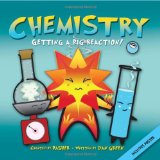The Basher Science series has a new addition released this month: Technology: A byte-size world! by Dan Green and illustrator/author Simon Basher.  This installment tackles machines, from simple to complex, and the materials that are used to create them.
This installment tackles machines, from simple to complex, and the materials that are used to create them.
You are probably already familiar with the Basher Science series, but if not, each topic generally consists of a two-page spread with illustrator/author Simon Basher’s unique cartoon illustrations that have the flavor of Japanese chibi on the right side and the text discussion on the left side. The text follows a formula of three bullet factoids, a paragraph or two of kicky first-person narrative about the topic with a few groan-worthy puns thrown in, and then three more bullet points.
As you might expect, this brief-and-flashy formula works better for some topics than others. Still, the kid-friendly tone of the characters and lack of density of the text entices struggling or jaded readers to give it a try, which is the book’s -and the series’- real strength. Once readers are drawn in, they will likely want more information on inventions such as such as a 3-D printer or a particle accelerator. Even though the brevity sometimes is frustrating, I have to admit that I often learn something new from these books. Did you know that rockets need to carry oxygen with them in order to fire in space? How about that rack-and-pinion steering was not patented until 1975?
Technology: A byte-size world is a byte-size introduction to the world of invention. For readers looking for something unique and refreshing, it will be a treat.
Note: This version comes with a detachable poster.
Other Basher book reviews:
Punctuation: The Write Stuff
Oceans: Making Waves!
Chemistry: Getting a Big Reaction!
For more information, be sure to visit the Basher Books website.
Reading level: Ages 10 and up
Paperback: 128 pages
Publisher: Kingfisher (July 17, 2012)
ISBN-10: 0753468204
ISBN-13: 978-0753468203
More books from the Basher series:
\
The book was provided by the publisher for review purposes.
Come visit the STEM Friday blog each week to find more great Science, Technology, Engineering and Math books.






